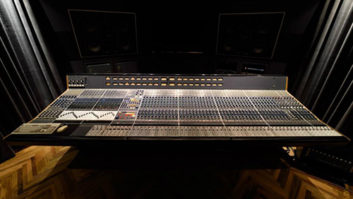
The AT3060 tube condenser microphone is a new addition toAudio-Technica’s 30 Series but with a twist: Its onboard tubeelectronics are 48-volt, phantom-powered and use ordinary XLR miccables; no bulky external power supply is required. According to A-T,removing the PS allowed the company to put more money into the mic’scomponents and manufacturing. Beyond the added expense of a powersupply and specialized cables, other practical advantages becomeapparent once you put this side-address cardioid mic to work. An ideal3060 application is location recording, where an AC source near the micmay not be readily available. Live sound mixers who would like to use awarmer tube mic will appreciate the mic’s “plug-and-play”aspect: no power supply to hide and protect onstage.
The 3060’s silver-painted brass body is the same as that of theAT3035’s open acoustical housing design, which reduces case resonances.The one-piece internal mic assembly — held in place by threesmall Phillips screws — easily slips out for inspection. The1-inch Mylar diaphragm is two microns thick and gold-vapor deposited.The entire capsule assembly with nickel-plated brass acoustic baffle issimilar to the one used in the A-T 40 Series mics.
The tube is a hand-selected, pre-aged, subminiature Raytheon 6418triode. Mounted near the bottom of the mic, it is connected bywhisker-thin wires soldered to a PC board below it. The rest of theamplifier components, voltage converters/regulators for the plate andfilament (and output XLR) are on this board. To prevent tubemicrophonics, the peanut-size triode is surrounded in foam andshock-mounted in a brass block. I was pleased to see a big outputtransformer (A-T says this contributes to the 3060’s low-frequencycharacter) and that the top end extends out to about 17 kHz, accordingto the frequency response plot.
IN THE STUDIO
Using the AT3060 is the same as any other phantom-powered mic: plugit in and go. The manual recommends waiting 10 minutes for warm up andstable operation, but the mic comes on nearly instantly (with no thumpor pop) and is ready to rock in a minute or so. The included AT8458shock-mount works well due to its clever design: Instead of a captiveclamp arrangement — which on other shock-mounts can wear out orbreak with repeated use — the 3060 body has a groove machinedaround its circumference that mates to supporting elastic cords. Oncethe cord ends click into this groove, it takes a good tug to remove themic. Not surprisingly, the mic never fell out, even when it wasinverted or shaken.
I used the AT3060 to record two different female singers, achromatic harmonica and acoustic guitars. For the singers, I used anAvalon VT-737SP channel and found the mic very clean, accurate andopen-sounding, with a very low noise floor. (Specs list EIN as 17 dBA.)The frequency chart shows a 2dB rise from 4 to 5 kHz and this was agood touch here; I didn’t use any EQ when recording or when I mixed theproject later on. I liked the warm bottom end, even when the girlssometimes “kissed” the mic: proximity effect, yes;boominess, no.
I had no mic overload or compression with loud and close singing,which is an initial concern, as there’s no attenuator pad. Iencountered no sibilance problems or high-frequency hiss, even thoughthe mic’s response extends to 17 kHz. This high-frequency response isflat and smooth rather than lifted like many tube mics: yet anotherreason to have this mic in your studio. However, the 3060’s tightcardioid polar pattern did require my singers to stay more “ontheir marks,” aimed at the front of the mic. With this in mind,I’m sure the 3060 would also be suited for live stage work due to itsgood off-axis rejection. I’d like to try an omni or maybe amultipattern version of this mic someday.
Recording chromatic harmonica was trouble-free: I miked it fromabove the instrument, just above the top of the player’s head, lookingdown at the middle of the harmonica about 10 inches away. My playermoved around a little to work the mic and I did have to EQ out a littleof the 2 to 5kHz area as the producer was looking for a more mellowtone out of this bright instrument. The 3060 captured all of theplayer’s mouth noises and breathing perfectly, while rejecting thenoise coming from a nearby air-conditioning vent. (I aimed the musicianand the back of the mic toward that vent.)
Acoustic guitars sounded full, yet bright and balanced. I requiredno roll-off (the mic has none) and placed the 3060 between the soundhole and the start of the fretboard, and about 18 inches out front. Forfingerpicking, I aimed the 3060 more toward the bridge and cranked upmic gain on Universal Audio’s new UA 6176 channel. I usually don’t likethe sound of large-capsule condensers on acoustics, but this micsurprised me! With nearly the same articulation as smaller-capsulecondensers, there was plenty of gain to capture it all with a good,solid bottom end.
The AT3060 retails at $599 MSRP and — like all Audio-Technicamics — has a one-year warranty. I found the mic’s all-aroundusefulness, smooth high-frequency response and warm sound make this onea solid winner. If you work in recording or live sound situations whereexternal supply is an issue, you’ll be even more impressed.
Audio-Technica, 330/686-2600, www.audio-technica.com.
Barry Rudolph is an L.A.-based recording engineer. Visit hisWebsite atwww.barryrudolph.com.







